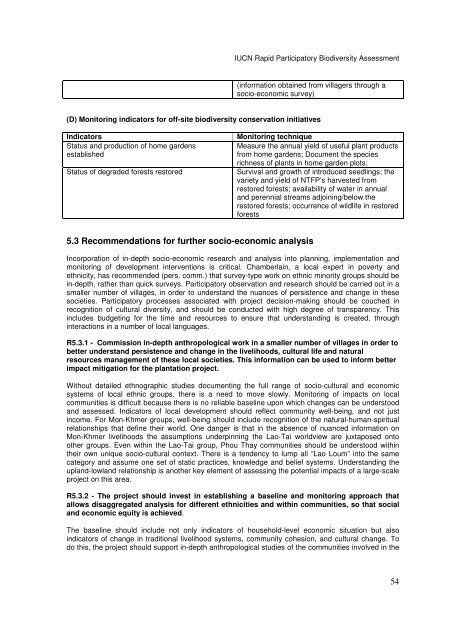Part 1 – A Rapid Participatory Biodiversity Assessment - IUCN
Part 1 – A Rapid Participatory Biodiversity Assessment - IUCN
Part 1 – A Rapid Participatory Biodiversity Assessment - IUCN
You also want an ePaper? Increase the reach of your titles
YUMPU automatically turns print PDFs into web optimized ePapers that Google loves.
<strong>IUCN</strong> <strong>Rapid</strong> <strong>Part</strong>icipatory <strong>Biodiversity</strong> <strong>Assessment</strong><br />
(information obtained from villagers through a<br />
socio-economic survey)<br />
(D) Monitoring indicators for off-site biodiversity conservation initiatives<br />
Indicators Monitoring technique<br />
Status and production of home gardens<br />
established<br />
Measure the annual yield of useful plant products<br />
from home gardens; Document the species<br />
richness of plants in home garden plots;<br />
Status of degraded forests restored Survival and growth of introduced seedlings; the<br />
variety and yield of NTFP’s harvested from<br />
restored forests; availability of water in annual<br />
and perennial streams adjoining/below the<br />
restored forests; occurrence of wildlife in restored<br />
forests<br />
5.3 Recommendations for further socio-economic analysis<br />
Incorporation of in-depth socio-economic research and analysis into planning, implementation and<br />
monitoring of development interventions is critical. Chamberlain, a local expert in poverty and<br />
ethnicity, has recommended (pers. comm.) that survey-type work on ethnic minority groups should be<br />
in-depth, rather than quick surveys. <strong>Part</strong>icipatory observation and research should be carried out in a<br />
smaller number of villages, in order to understand the nuances of persistence and change in these<br />
societies. <strong>Part</strong>icipatory processes associated with project decision-making should be couched in<br />
recognition of cultural diversity, and should be conducted with high degree of transparency. This<br />
includes budgeting for the time and resources to ensure that understanding is created, through<br />
interactions in a number of local languages.<br />
R5.3.1 - Commission in-depth anthropological work in a smaller number of villages in order to<br />
better understand persistence and change in the livelihoods, cultural life and natural<br />
resources management of these local societies. This information can be used to inform better<br />
impact mitigation for the plantation project.<br />
Without detailed ethnographic studies documenting the full range of socio-cultural and economic<br />
systems of local ethnic groups, there is a need to move slowly. Monitoring of impacts on local<br />
communities is difficult because there is no reliable baseline upon which changes can be understood<br />
and assessed. Indicators of local development should reflect community well-being, and not just<br />
income. For Mon-Khmer groups, well-being should include recognition of the natural-human-spiritual<br />
relationships that define their world. One danger is that in the absence of nuanced information on<br />
Mon-Khmer livelihoods the assumptions underpinning the Lao-Tai worldview are juxtaposed onto<br />
other groups. Even within the Lao-Tai group, Phou Thay communities should be understood within<br />
their own unique socio-cultural context. There is a tendency to lump all “Lao Loum” into the same<br />
category and assume one set of static practices, knowledge and belief systems. Understanding the<br />
upland-lowland relationship is another key element of assessing the potential impacts of a large-scale<br />
project on this area.<br />
R5.3.2 - The project should invest in establishing a baseline and monitoring approach that<br />
allows disaggregated analysis for different ethnicities and within communities, so that social<br />
and economic equity is achieved.<br />
The baseline should include not only indicators of household-level economic situation but also<br />
indicators of change in traditional livelihood systems, community cohesion, and cultural change. To<br />
do this, the project should support in-depth anthropological studies of the communities involved in the<br />
54

















